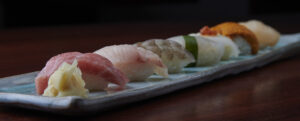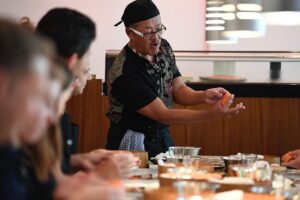Sushi, as we know the dish today, consists of leavened rice, fish, vegetables, nori and some seasoning ingredients such as wasabi and soy sauce.
However, this was not always the case: originally, soaking fish in cooked rice was simply a method of fermenting the fish in a controlled manner to preserve it.
The rice was not eaten, the fish was roughly reminiscent of properly aged cheese in flavor.
Sushi has evolved over two millennia into what we know today as sushi - and in the 20th century, this evolution was particularly rapid. Let's take a closer look at at least some of the ingredients.
Rice cultivation as a cultural asset
When and where exactly rice was first cultivated is still not clear. But the fact is that, with the exception of a single type of rice eaten in Africa, all the types of rice eaten today belong to the species Oryza sativa. And it was cultivated once, probably at least 8,200 years ago in what is now China. One locates this one, original domestication in the area of the Pearl River Delta. From there, rice spread as a cultivated plant for food first in China, and from there later to Southeast Asia and India.
Rice cultivation only since circa 300 B.C. in Japan
Rice cultivation and the associated knowledge probably came to Korea around the end of the 2nd millennium BC, and to Japan at the latest around the year 300 BC. Rice phytoliths have been found in pottery of the Middle Jōmon period. However, actual identified rice grains date to the late Jōmon period around 1,000 to 800 BC. Presumably, the rice took the route to Japan via present-day Korea, but even this is not entirely certain.
In the Jōmon period, rice cultivation usually meant dry fields. Wet rice cultivation was probably common in China from about 10,000 B.C., but in Japan we know the earliest rice fields of this type from the years around 300 B.C.. Evidence and dates include fields at Itazuke on Kyushu (cf. https://antikewelt.de/2021/09/16/die-zeit-des-wandels-die-yayoi-zeit-in-japan/).
At that time, Japan used natural wetlands, rice cultivation became known starting from the south to the north. More than 200 sites of rice fields from this era are known today between Kyushu and Sunazawa and Tareyanagi (Aomori).
With the rice came tools and settlements
The rice did not come alone: New techniques in pottery making and tool working also came to Japan at this time. People now settled in settlements and largely abandoned their previously seasonally nomadic way of life. With rice, life in Japan changed fundamentally.

Rice and Shintō: about the special meaning of rice in Japan
Considering the profound changes that accompanied the cultivation of rice in your early days, it is not surprising that the cultural significance of rice goes far beyond that of a mere food among many. Once again, Japan's particular isolated insularity and rugged geography proves to be an interface where the peculiarities of the Japanese cuisine Washoku have emerged.
Every Japanese knows that in every grain of rice live seven deities
To this day, the emperor himself sows rice in the palace garden, plants the seedlings in beds specially prepared for this purpose in the palace garden and harvests the rice himself. The tasting of the new rice is an annual festival that dates back to Japan's oldest mythological tales. The first rice plants are said to have emerged from the body of the dying food goddess herself, when the gods still walked the earth. And to this day, popular belief knows that seven deities reside in each individual grain of rice.
However, no one knows what the name of the gods in the rice...
Shintoism, which is widespread in Japan (in Japan, Buddhism and Shintoism exist in parallel, not mutually exclusive), assumes that all things are animate, i.e. provided with a thinking being. This applies to stones, mountains, ocean currents and trees as well as to an aging umbrella, worn slippers and rice.
Why there are supposed to be seven kami-sama, i.e. deities, located in each individual grain of rice is not entirely clear. But the gods of fortune of Japan, demonstrably anchored in popular belief since the Muromachi period (1477-1573), are also seven in number. Unlike these, however, the myriad deities who make their home in a bag of rice are nameless. Why this is so, nobody knows. But this is also typical Japanese somewhere - anything else would be too easy 😉
Little rice lesson: The variety makes the taste
Today, "sushi" no longer means fish, but a rice dish that can be served with fish, vegetarian ingredients or even meat.
The most important ingredient of sushi is "shari", the mildly acidified rice
It is a science in itself to prepare the rice with just the right amount of rice vinegar, sugar and salt. The rice is so important to sushi that sushi chefs-in-training in Japan first spend two years cooking and seasoning only rice before they are even allowed to touch the fish. Larger sushi bars in Japan used to employ clerks who dealt exclusively with the rice.
In Japan (of course) only rice of the genus Japonica
In Japan, only Japonica rice is used. The rice grains are slightly shorter and rounder than indica rice. And they are stickier. Sushi rice is Japonica rice, and usually a variety with medium-length rice grains. The secret of this rice lies in its starch. This is because each consists of bundles of irregularly arranged sugars, usually between 5,000 and 20,000 per chain. The molecular chains are also not arranged regularly, but look more like a spiky pile. This is why the rice sticks. The special feature of the preferred type of rice for sushi is the shape of the rice grains: they are no more than two or three times as long as they are wide. This shape makes it easier to press the rice into the right shape without it becoming a solid block.
In Japan, people prefer the Koshi-Hikari variety for sushi. Even after peeling and polishing, this rice still contains aromatic fatty acids that give the rice flavor and a slightly moist feeling in the mouth. Particularly high quality Koshi-Hikari is allowed to dry in the sun after harvest. Less expensive is the rice dried industrially with hot air.
Brown rice or white rice?
One often reads and hears that the snow-white shining, quite delicately fragrant Japanese rice is a modern thing, which was so only in the economically well-off households. For centuries, the common people had to make do with brown, unhusked rice. This is only partially correct.
In fact, rice was reserved for the better-off for centuries anyway.
Millet and legumes, on the other hand, were much more widespread than they are today. When the folktale Momotarō speaks of kibi-dango, of millet balls, this is quite realistic. Millet was used as rice is today. The steamed or boiled seeds were mixed with legumes or other ingredients and pressed into balls that served as a meal on the go. This may be comparable to today's onigiri, minus nori.
Technical development determines how white the rice is
But what did the rice look like? Today's white rice is a product of excellent technology. It is not only hulled and freed from the germ, but also polished. This means that all the dark particles from the husk and germ are really gone. But only machines developed in the course of the 20th century work this cleanly. Before that, wooden tools were used to thresh the rice to free the fine grains from their hard husks and make them edible. Part of the thin layer under the husk, rich in fiber and minerals, remained attached to the rice grain and could not be removed. And this was also true for the rice of the higher social classes. So, color-wise, rice was beige to light brown through most of Japanese history. Today's whole grain rice is darker.
Beri beri widespread disease
With the preference for white rice and its spread among large sections of the population, a disease also spread in Japan: beri-beri was long considered a national ailment. This is because the rice loses a large proportion of its B vitamins during the polishing process. Beri-beri is a deficiency disease.
But even with the pure rice that we know today, sushi was not white. Because the rice was fermented for a long time. He darkened in the process. Even Edomae sushi, the quickly prepared nigiri of old Edo, was not white. For here, a reddish rice vinegar was used to acidify the rice, which tastes stronger and gives the rice a delicate reddish-brown shimmer.
Secret of the pros: Nikiri
Sushi is not always served ready seasoned. Often, the individual appetizers come to the guest with a small bowl of brown sauce. However, this is not soy sauce, as is often assumed. Soy sauce is so intense in flavor that it would simply mask the complex flavors of sushi. This mysterious sauce is called Nikiri. The base of nikiri is again dashi, the clear broth based on fish and seaweed.
Konbu and Bonito for ATP and IMP
Dashi is made by boiling 昆布 (konbu, a type of seaweed) and 鰹節 (katsuobushi, bonito flakes).
Konbu naturally contains large amounts of glutamate. This is the substance that makes dashi, and therefore nikiri, so tasty. But it's only half the secret. The other half lies in the production of the bonito flakes.
Bonito is a tuna in whose muscle meat stores high amounts of adenosine triphosphate (ATP for short). To produce the flakes, the fillet of the fish is cooked and then smoked for ten to twenty days. The fish is infected with mold and left for two weeks. Then the fish is dried in the sun, the old mold is scraped off, new mold is applied and the fish is left to rest again for several weeks. The procedure is repeated three to four times. During this process, enzymes break down the proteins in the fish meat into amino acids. The ATP in particular is broken down into a whole range of other molecules. Among them is inosine monophosphate, or IMP for short. The human taste buds react to this in the same way as to glutamate.
After a few weeks of drying and mold treatment, the bonito fillet is as hard as a piece of wood. Fine shavings or flakes of it are taken off with a plane. This is katsuobushi, again an ingredient closely associated with the specific region of Japan, which appears on all corners of Japanese cuisine and is attracting more and more attention from star chefs around the world. By the way, this is also a reason why Japanese cuisine is very rarely "pure" vegetarian: because almost everywhere Katsuobushi is included as a kind of base.
Exact quantities are a secret
Dashi is the basic ingredient for Nikiri. Soy sauce, sake and mirin are also added. Every sushi chef has his own secret recipe for Nikiri. However, the standard recipe calls for 100 parts soy sauce, 20 parts dashi, 10 parts sake and 10 parts mirin.
While today Nikiri is sometimes served with sushi instead of soy sauce, a traditional sushi chef delicately applies Nikiri with a brush before the individual piece of sushi is released to the guest.
Soy sauce as a by-product of miso production
Apart from the fact that every successful Japanese meal is only completed with a small bowl of miso soup, miso has nothing to do with sushi. Indirectly, however, it does. Soy sauce is a by-product of miso production.
Miso is also a fermented food
Miso is made on the basis of soybeans.
But before it comes to the soybeans, rice is infected in large quantities with the mold 麹 (kōji, Aspergillus oryzae). As soon as the fungus has permeated the entire rice, cooked soybeans and some salt are added. In industrial production, there are 5,000 pounds of soybeans for every 6,600 pounds of rice. Bacteria and yeasts are also supplemented.
While the enzymes of the Kōji break down the proteins in rice and soybeans into manageable amino acids, and break down the carbohydrates into simple sugars, the Kōji quickly dies due to lack of oxygen.
The glucose and sugar are converted by the bacteria into lactic acid and acetic acid. The yeast cultures also like sugar, converting it into alcohol. The alcohol in turn reacts with the acids produced by the bacteria to form fruity esters.
We know these flavors not only from miso, but also find them in a good wine. When Kōji, bacteria and yeasts have done their work, the mixture of rice and soybeans has become miso.
Miso is very rich in natural glutamate.
Soy sauce was originally a byproduct
However, during the production of miso, a brown, strong-smelling liquid also falls off. This liquid also contains all the interesting flavor components of miso, including glutamate. This is Soy sauce.
Probably about 1,200 years ago, people discovered how tasty soy sauce is.
In the sixth century, Buddhism arrived in Japan with its ban on meat. At that time, the Japanese aristocracy was accustomed to the taste of meat and fish.
Soy sauce had the potential to make aristocratic cuisine Buddhist-compliant. But soy sauce remained a luxury product for another 700 years or so. It wasn't until around the 1500s that people figured out how to make soy sauce more specifically. Now wheat was added during fermentation, which made the soy sauce sweeter.
Excursus: Glutamate, the substance that gets taste buds high
Both soy sauce and miso and dashi and the base katusobushi and konbu were about glutamate. Glutamate has a bad reputation as a flavor enhancer. Why is that?
In 1908, the Japanese chemist Kikunae Ikea discovered that glutamate is the substance that makes Konbu-based broth so delicious. He realized that glutamate could also be produced industrially. The product is now known as monosodium glutamate, or MSG for short (not to be confused with MSG = Michael Schenker Groupwhich was also known as the McAuley Schenker Group for a time).
A few years later, a colleague (also Japanese) came up with the idea that IMP is what makes bonito-based broth so tasty. Inosine monophosphate makes any kind of fish a delicacy and is always produced when the ATP in the muscle cells is decomposed after the fish dies. IMP can also be produced industrially. Like MSG, it is used today as a flavor enhancer.
Umami flavor
For a long time, it was believed that human taste buds would perceive either sweet or salty or sour or bitter.
Japanese scientists found that receptors for umami are also located on the human tongue. These receptors react to various amino acids such as glutamates and IMP.
Because this is now known, MSG is added to many types of finished products, including sausages and meat products. This is because modern factory farming leaves little room for the development of natural meat flavor. With MSG, flavor comes back into foods of animal origin. MSG is often declared as "yeast extract" or as "vegetable protein".
Glutamate is naturally present in tomatoes, many cheeses and fish.
Important for the taste: nori and wasabi
Today, sushi is hardly conceivable without nori. The crunchy green leaves are obtained from dried and pressed red algae. They have only been used for sushi since the 20th century, and that is thanks to a British woman. According to reports, people in Japan were already eating the "black leaves" in the 18th century (see Corson, p. 82). But just not with sushi.
The "black paper" from the sea
Nori was invented in Asakusa, a district of present-day Tōkyō.
The red algae had to be collected in the wild; they could not be cultivated in a controlled manner. This was only achieved after 1950, after the British Kathleen Drew-Baker had discovered how the algae reproduce. In the Ariake Sea in southern Japan, a granite column still stands today, showing a portrait of Drew-Baker and dubbing her the "Mother of the Ocean." Asia's entire nori industry is based on her findings.
Maki sushi didn't really become popular in Japan until the second half of the 20th century, and that's thanks to American sushi creations.
A touch of spiciness
Wasabi is an entirely different matter.
Often referred to as horseradish, this is a root that is related to horseradish but tastes different. Wasabi is incredibly finicky and can only be cultivated under the most difficult conditions. That's why real wasabi is extremely expensive. The root is grated fresh and consumed immediately in small quantities.
Today mainly used cheap substitute products
What is used today to season sushi is a green paste made from various powders, similar to a curry mixture. The color is artificially added, the fine powder is mixed with water to make the paste that most people know as wasabi. Taste-wise, it has almost nothing to do with the real wasabi.
And contrary to what most people believe, wasabi on fish is not antibacterial either. Wasabi does not kill pathogens or parasites.
But wasabi creates conditions in the stomach that are simply hostile to pathogens. Preventively against food poisoning, wasabi is therefore quite a useful thing (cf. Corson, p. 161). Wasabi has been used in Japan since about the 10th century.
Try fresh wasabi in Munich
Wasabi can only be cultivated really well in Japan - it requires a very special mixture of sun, shade, fresh water and minerals in the water.
Handling fresh wasabi is also not easy.
With us in the Restaurant sansaro in Munich you can always try fresh wasabi. We particularly recommend this for Sashimi. Ask the service staff about it, we look forward to your visit!
Appendix: sources used and further information
https://www.mizkan.co.jp/sushilab/manabu/0.html
https://rekishi-memo.net/japan_column/sushi.html
https://sushi-all-japan.com/index_b2_1.html
https://1200irori.jp/content/learn/detail/case17
https://jpnculture.net/sushi/
https://gogonihon.com/de/blog/japanisches-sushi/
Click the button below to download the content from jpnfood.com.
https://www.pbs.org/food/the-history-kitchen/history-of-sushi/
https://www.japandigest.de/kulturerbe/geschichte/geschichte/yayoi-zeit/
Click the button below to load the content of www.rokaakor.com.
https://ja.wikipedia.org/wiki/%E6%B1%9F%E6%88%B8%E5%89%8D%E9%AE%A8%E8%81%B7%E4%BA%BA%E3%81%8D%E3%82%89%E3%82%89%E3%81%AE%E4%BB%95%E4%BA%8B
Click on the button below to load cuisine-kingdom.com content.
Click on the button below to load cuisine-kingdom.com content.
Click on the button below to load cuisine-kingdom.com content.
https://www.sushi-guide-morita.de/index_jp.html
Click on the button below to download the content of antikewelt.de.
Buruma, Ian: Japan Behind the Smile. Gods, gangsters, geishas. Ullstein Paperback, Frankfurt am Main 1988
Corson, Trevor: The Story of Sushi. An Unlikely Saga of Raw Fish and Rice. Harper Perennial, New York 2008.
Hadamitzky, W.; Spahn, M.; Putz, O., Arnold-Kanamori, H. et al: Langenscheidt's Large Japanese-German Dictionary. Character dictionary. Langenscheidt, Berlin and Munich 1997
Ienaga, Saburō: Cultural History of Japan. Iudicium Verlag, Munich 1990
Issenberg, Sasha: The Sushi Economy. Globalization and the Making of a Modern Delicacy. Gotham Books, published by Penguin Group, London 2007.
Marra, Michael F.: A History of Modern Japanese Aesthetics. University of Hawai'i Press, Honolulu 2001
Naumann, Nelly: The Myths of Ancient Japan. Anaconda Publishing House, Munich 2020
Tomiyama, Yoshimasa; Miura, Yukio; Yamaguchi, Kazuo:Ikubundo Japanese-German Dictionary. Ikubundo Publishing House, Tokyo 1996






